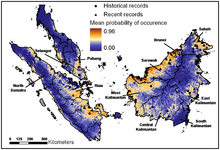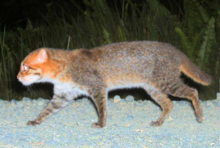Flat-headed cat: Difference between revisions
Extended confirmed users, Pending changes reviewers 53,992 edits →Intro: updated ref |
Extended confirmed users, Pending changes reviewers 53,992 edits */intro*/ extended with ref |
||
| Line 20: | Line 20: | ||
}} |
}} |
||
The '''Flat-headed Cat''' (''Prionailurus planiceps'') is a small wild [[felidae|cat]] patchily distributed in the [[Thai-Malay Peninsula]], [[Borneo]] and [[Sumatra]]. Since 2008, it has been listed as [[Endangered species|Endangered]] by the [[IUCN]] due to destruction of [[wetland]]s in their habitat.<ref name=iucn>{{IUCN |assessors=Wilting, A., Hearn, A., Sanderson, J., Ross, J. and Sunarto, S. |year=2010 |id=18148 |taxon=Prionailurus planiceps |version=2010.4}}</ref> |
The '''Flat-headed Cat''' (''Prionailurus planiceps'') is a small wild [[felidae|cat]] patchily distributed in the [[Thai-Malay Peninsula]], [[Borneo]] and [[Sumatra]]. Since 2008, it has been listed as [[Endangered species|Endangered]] by the [[IUCN]] due to destruction of [[wetland]]s in their habitat. It is suspected that the effective population size could be fewer than 2,500 mature individuals, with no subpopulation having an effective population size larger than 250 adult individuals.<ref name=iucn>{{IUCN |assessors=Wilting, A., Hearn, A., Sanderson, J., Ross, J. and Sunarto, S. |year=2010 |id=18148 |taxon=Prionailurus planiceps |version=2010.4}}</ref> |
||
Like some other small cats, it was originally placed in the [[genus]] ''[[Felis]]'', but is now considered one of the five species in ''[[Prionailurus]]''.<ref name=msw3/><ref name=walker>Nowak, R. (editor) 1999. ''Walker's Mammals of the World.'' 6th edition. ISBN 0-8018-5789-9</ref> |
Like some other small cats, it was originally placed in the [[genus]] ''[[Felis]]'', but is now considered one of the five species in ''[[Prionailurus]]''.<ref name=msw3/><ref name=walker>Nowak, R. (editor) 1999. ''Walker's Mammals of the World.'' 6th edition. ISBN 0-8018-5789-9</ref> |
||
Revision as of 21:53, 13 October 2011
| Flat-headed Cat[1] | |
|---|---|

| |
| Scientific classification | |
| Kingdom: | |
| Phylum: | |
| Class: | |
| Order: | |
| Family: | |
| Genus: | |
| Species: | P. planiceps
|
| Binomial name | |
| Prionailurus planiceps | |

| |
| Range of Flat-headed Cat[3] | |
The Flat-headed Cat (Prionailurus planiceps) is a small wild
Like some other small cats, it was originally placed in the genus Felis, but is now considered one of the five species in Prionailurus.[1][4]
Flat-headed cats are very rare in captivity, with less than 10 individuals, all kept in Malaysian and Thai
Charactersitics
The flat-headed cat has a thick fur that is generally dark reddish-brown tinged grey, with a more reddish head and whitish underparts. Except for the relatively faint facial streaks, it is rather unpatterned. The legs are fairly short, and the ears are short and round. Its name comes from its flattened head.[6] It has a head-and-body length of 41 to 50 cm (16 to 20 in) and a short tail of 13 to 15 cm (5.1 to 5.9 in).[4] It weighs 1.5 to 2.5 kg (3.3 to 5.5 lb).[7]
The inter-digital webs on its paws help the cat gain better traction in muddy environments and water, and are even more pronounced on this cat than those on the paws of the
Distribution and habitat

The distribution of flat-headed cats is restricted to lowland
Flat-headed cats occur in both
Ecology and behavior
Flat-headed cats are presumably solitary, and probably maintain their home ranges by
The stomach contents of an adult shot on a Malaysian riverbank consisted only of fish. They have been observed to wash objects, raccoon-style. Live fish are readily taken, with full submergence of the head, and the fish were usually carried at least two meters away, suggesting a feeding strategy to avoid letting aquatic prey escape back into water. Captive specimens show much greater interest in potential prey in the water than on dry land, suggesting a strong preference for riverine hunting in their natural habitat.[11] Their morphological specialization suggest that their diet is mostly composed of fish, but they are reported to hunt for frogs, and are thought to catch crustaceans.[6] They also catch rats and chicken.[8]
Vocalizations of a flat-headed cat kitten resembled those of a
Their
Threats
Flat-headed cats are primarily threatened by wetland and lowland forest destruction and
They are also threatened by
Conservation
The flat-headed cat is included on
References
- ^ OCLC 62265494.
- ^ a b c d Template:IUCN
- ^
- ^ a b Nowak, R. (editor) 1999. Walker's Mammals of the World. 6th edition. ISBN 0-8018-5789-9
- ^ International Species Information System (2011) Captive Prionailurus planiceps. Accessed 13 October 2011
- ^ ISBN 0-226-77999-8.)
{{cite book}}: CS1 maint: multiple names: authors list (link - ^ Francis, C. (2001) A Photographic Guide to Mammals of South-east Asia including Thailand, Malaysia, Singapore, Myanmar, Laos, Cambodia, Vietnam, Java, Sumatra, Bali and Borneo. ISBN 85974 507 5
- ^ a b c d e f Nowell, K., Jackson, P. (1996) Flat-headed Cat. Prionailurus planiceps. In: Wild Cats: status survey and conservation action plan. IUCN/SSC Cat Specialist Group, Gland, Switzerland.
- ^ Payne, J., Françis, C. M., Phillipps, K. (1998) A Field Guide to the Mammals of Borneo. Sabah Society. 3rd reprint, ISBN 967-99947-1-6
- ^ Leyhausen, P. (1979) Cat behaviour. The predatory and social behaviour of domestic and wild cats. Garland STPM Press; New York.
- ^ Muul, I., Lim, B. L. (1970) Ecological and morphological observations of Felis planiceps. Journal of Mammalogy 51 (4): 806–808.
- ^ Peters, G. (1981) Das Schnurren der Katzen. Säugetierkundliche Mitteilungen 29: 30–37.

